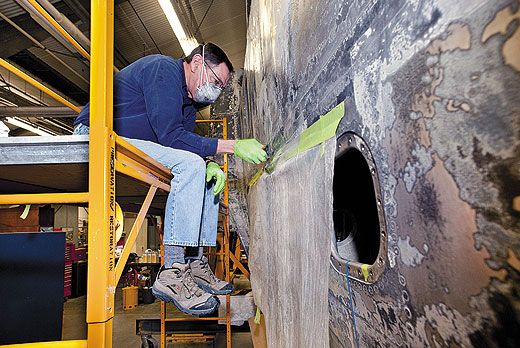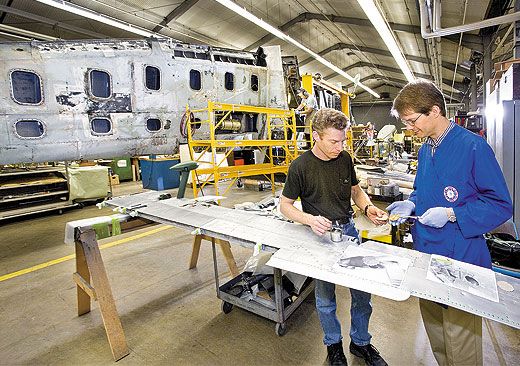In the Museum: Painting History
Restoring the sole surviving Heinkel He 219.
/https://tf-cmsv2-smithsonianmag-media.s3.amazonaws.com/filer/In-The-Museum-9-1-2012-2_FLASH.jpg)
Arguably the best night fighter the Luftwaffe ever produced, the Heinkel He 219 entered the war in mid-1943 and was so immediately successful against Royal Air Force bombers that the British must have been glad that no more than 294 were built. Today, only one remains. So when the National Air and Space Museum decided to restore and repaint the world’s sole surviving 219, a group of curators, restorers, and conservators met to discuss the project.
“Every artifact is different: its background, its service history, and the people involved,” explains Russell Lee, a curator in the Museum’s aeronautics division. “So a curator has to look at all of those things as he or she formulates a [restoration] plan.”
The Museum’s 219 was captured toward the end of World War II, at Grove air base in Denmark, taken as part of Operation LUSTY, a U.S. Army Air Forces Intelligence program to bring enemy aircraft, weapons, and scientific data to the United States for study.
“We’re not sure whether this aircraft flew operational missions,” says Lee, “or how fully equipped it was.”
After arriving in the United States, the 219 was flight tested at Freeman Field, Indiana. At some point, its German markings were painted over, and U.S. markings applied.
After flight testing, many captured enemy aircraft were displayed at airshows, a practice that may explain the 219’s third paint job, an attempt to return the aircraft to its original configuration.
When the restoration began, says project lead David Wilson, “we didn’t know the full history of the aircraft, and we were sort of confused at some of the things we were finding.” He notes, for example, “The insignias seemed to be in the wrong location and of the wrong proportions.”
The fuselage restoration was completed in 2003, but Wilson continued to puzzle over how to paint the wings. Restorers used a technique called wet sanding to learn more about the aircraft’s history. During this time-consuming process, restorers take very fine sandpaper—between 1,000-grit and 2,000-grit—soaked in water, and carefully sand the artifact. Wet-sanding the entire wing took approximately six months.
The Museum tries to keep original paint whenever possible, “but in this case,” says Wilson, “the paint seemed very unstable. We were concerned that if we overpainted it and left the original remnants there that we would have adhesion problems with both the new and old paint.”
The 219’s upper fuselage was painted in German Wellenmuster camouflage, informally known throughout the restoration shop as “the squiggle.”
Large sheets of Mylar were laid over the upper fuselage, and Wilson and the others traced the camouflage pattern onto the plastic sheets so that it could be reproduced exactly, after they finished chemically stripping the metal.
The same attention to detail was given to stencil remnants found on two antennas under the starboard wing. Four lines of illegible text appeared on the scraped and battered surface. Wilson used a Mylar overlay to trace what he could of each stencil, but a lot of information was missing. After weeks of research, Wilson located someone who had the same antenna for sale, and was able to fill in the missing text.
Each artifact requires a different approach. Lee’s most recent restoration was the Vought V-173 Flying Pancake. Even though the restoration took eight years, the paint “wasn’t a hard choice,” says Lee. “We knew what the paint scheme was, and it didn’t change throughout its operational life. There’s lots of photo documentation, so that was easy.”
Not so with the Museum’s Hawker Hurricane Mk. IIC, which arrived with a completely stripped exterior. While Lee and Wilson were fairly confident of the authentic camouflage and under-surface colors, they couldn’t verify the original stencils. “Rather than put something on that was incorrect,” says Wilson, “we opted to leave it off.” While the restoration was completed in 1999, Wilson continued to research the Hurricane’s history, recently spending two weeks at the Royal Air Force Museum in England. The trip provided him with the information he needed to replicate the original stencils. “Dave’s discovery encourages us to hew to our goal of maintaining authenticity,” says Lee.
“The Smithsonian has one of the best collections of untouched Japanese and German aircraft,” says Wilson. “There are a lot of questions about the type of paints they used, and the stenciling. We are in a very good position to answer these questions. But we also know that once we restore an aircraft, we have only one chance to document everything. Once it’s gone, it’s gone. So we try and go to the extra effort of making sure that the documentation of everything we do is exceptional.”
Wilson has confirmed that by the time the Museum’s 219 was built, the aircraft’s exterior panels were not primed at all, unless they were steel or magnesium, as the Germans were experimenting with primerless paints in an effort to save time and weight.
The restorers also discovered an inscription penciled on a spar by the left wing heater bay, an odd blend of Russian and Ukrainian, possibly from one worker to another. “The aircraft is clean,” reads the informal scribbling. “Therefore there is little work to be done.”
Not so for Wilson and the rest of the team. It will take at least a month to finish painting the wing, which will then be reunited with the fuselage already on display.

